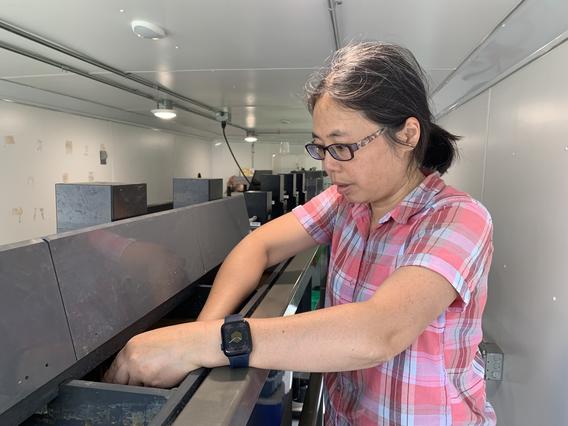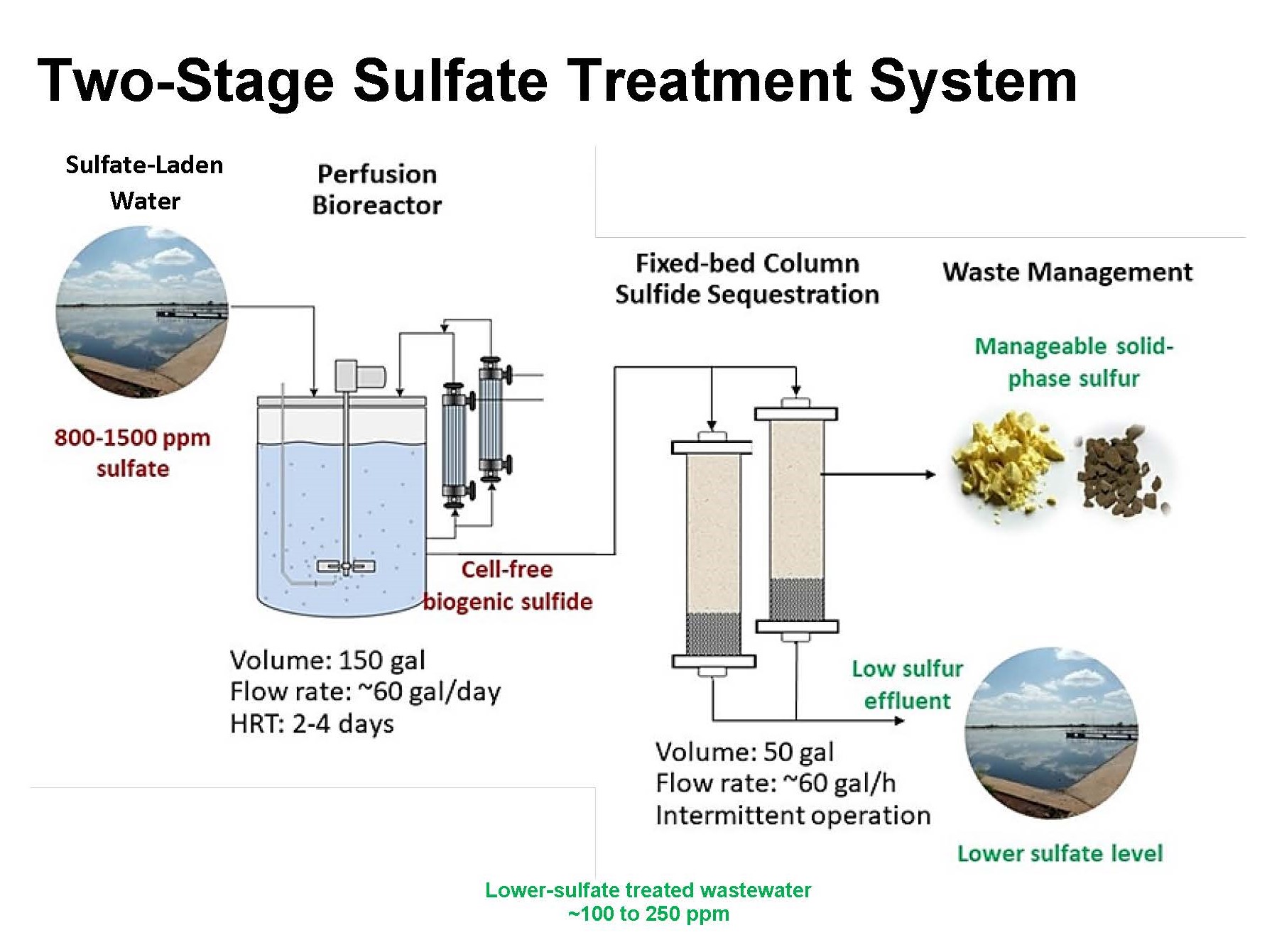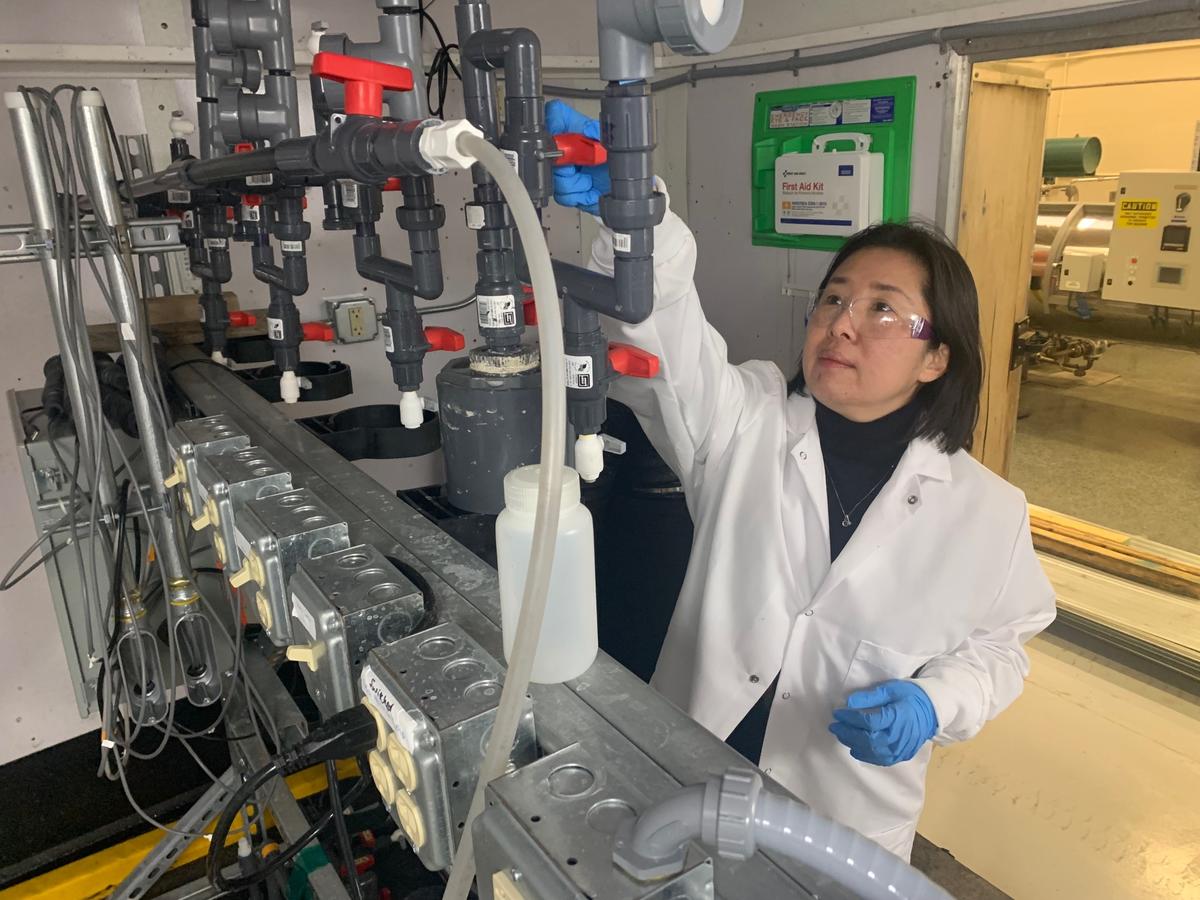Minnesota has a globally unique challenge to reduce sulfate levels in wild rice water bodies to 10 parts per million (ppm). It’s a regulatory standard set so low that no other states or countries have even tried to develop a way to achieve that. For comparison, the drinking water standard for sulfate levels is 250 ppm.
Sulfate concentrations at high levels also cause scaling and corrosion in industrial infrastructure during water reuse processes. The need to manage sulfur-rich dissolved solids is a challenge for mining, power generation, paper production and other industries.
NRRI has taken on these challenges by developing multiple processes that can reduce sulfate concentrations in a variety of wastewaters and for varying sulfate levels. Three of these technologies have achieved success in lab tests, and two of them have been piloted and demonstrated in real-world applications.
Ready for the Next Step
In March, NRRI’s lead researchers presented the state of the technologies in a webinar to a variety of stakeholders – from industry representatives to state and tribal resource managers. The 78 registrants got an overview of three approaches, each having specific benefits and challenges to be addressed.
“NRRI is really pushing the envelope to make a positive impact for Minnesota,” said Jill Crawford-Nichols, NRRI’s Technology Development Manager. “These technologies are ready for the next milestone and we will need the right partnerships to get them there.”
A Challenge for Minnesota and Beyond
In April 2022, the Minnesota Pollution Control Agency identified three new water bodies impaired by sulfate levels that could harm wild rice growth. The Agency’s bi-annual accounting is required by the federal Clean Water Act to list, and make publicly available, impaired waters that fail to meet water quality standards.
NRRI is developing treatments that target three different levels of sulfate in Minnesota waters:
- 50 – 250 ppm (typical range in municipal water treatment facilities) treated to 10ppm and lower.
- 250 – 2,000 ppm (range associated with mine pit lakes and agricultural runoff) treated to below 250 ppm.
- Greater than 2,000 ppm (associated with power generation and industry effluent) treated to greater than 250ppm.
“Each of these challenges may require a portfolio of two or more technologies in combination,” explained NRRI Director of Research, Lucinda Johnson. “There are technologies out there now – reverse osmosis and nanofiltration – but the cost and infrastructure are expensive.”
Treatment Technology 1: Low Sulfate Levels (Targeting Level 1)

Sulfate dissolves in water, which makes it challenging to remove. But when barium chloride is added, the sulfate reacts rapidly to form small particles of insoluble barium sulfate, or barite. A second flocculant chemical is then added which clumps the particles together so the barite sinks and can be removed. A final filter is added at the end of the process.
“This process has been used to remove sulfate at high concentrations, so it’s not new,” said Mei Cai, lead researcher and NRRI environmental engineer. “But it hadn’t been accomplished at such low sulfate levels.”
The effort started five years ago in the lab and successful results led to a scaled-up pilot system deployed in a trailer to three water treatment facilities in northern Minnesota. The system successfully reduced sulfate levels to below 10 ppm and a lot was learned. This technology currently operates at a small scale of 1 to 2 gallons per minute and is being developed for full-scale application.
“It’s a very simple system and uses existing equipment at the treatment plants,” said Cai. “But we’d like to figure out how to manage the chloride that is left in the water and develop a strategy for repurposing the resulting sludge. We also need to develop a plan for commercial application of the technology.”
Treatment Technology 2: Mid-Range Sulfate Levels (Targeting Levels 2 & 3)
Certain bacteria have evolved to metabolize sulfate, similar to how humans metabolize food. These bacteria are widely present in the environment and are being applied in an active sulfate reduction process. In this case, the bacteria are collected from the environment and grown in a controlled bioreactor. Sulfate-containing water is passed through the bioreactor.
The bacteria consume sulfate and convert it to sulfide which reacts with iron, resulting in a stable iron sulfide that can be safely stored. The iron used in the process is Minnesota taconite byproducts. A pilot-scale system was recently deployed at an energy production plant and successfully reduced sulfate from 2,000 to 3,000 ppm to less than 500 ppm.

“Now, with our grasp of the underlying process, we think we can begin to test and implement this approach on a larger scale using commercially available equipment,” said Nate Johnson, environmental engineer at UMD. “I think we can have this active biological sulfate remediation process ready in the next 3 to 5 years, or sooner if we can get the right partners to help us move to the next phase of development.”
Technology 3: Wide-Range and Elevated Sulfate Levels (Targeting Levels 2 & 3)
A passive, electrochemically-enhanced bioremediation method is being developed in the lab to address a wide range of sulfate levels (from 400 to >2,000 ppm). It uses the same sulfate-consuming bacteria in a landscape-scale treatment system, like an engineered wetland.
“We use electrodes to ‘tickle’ the bacteria which makes them more active,” explained Chan Lan Chun, NRRI environmental engineer. “Pit lake water can be passively fed into the landscape to reduce sulfate levels with electricity generated by solar panels.”
Currently, this process is being tested in a lab-scale bioreactor with sulfate-impacted soil. The researchers are working to control the sulfate reduction rate while limiting mercury methylation reactions during the process. Chun and her team are also working on a conceptual design for a scaled-up demonstration process using mathematical simulation.
Partners Wanted
Moving these technologies forward for real impact around the state requires key partnerships and creative thinking. The hope is that the broader teams built around the sulfate challenge will lead to commercialization.
“This program really showcases NRRI’s mission to deliver integrated research solutions for Minnesota,” said Rolf Weberg, NRRI Executive Director. “We took on this challenge with key partnerships and state legislative support, but it’s time to push this beyond our walls with a bigger team effort.”
For more information, contact Tim White, NRRI director of Partnership Development, at twwhite@d.umn.edu.
PHOTO TOP: Chan Lan Chun works in the biological treatment trailer.
